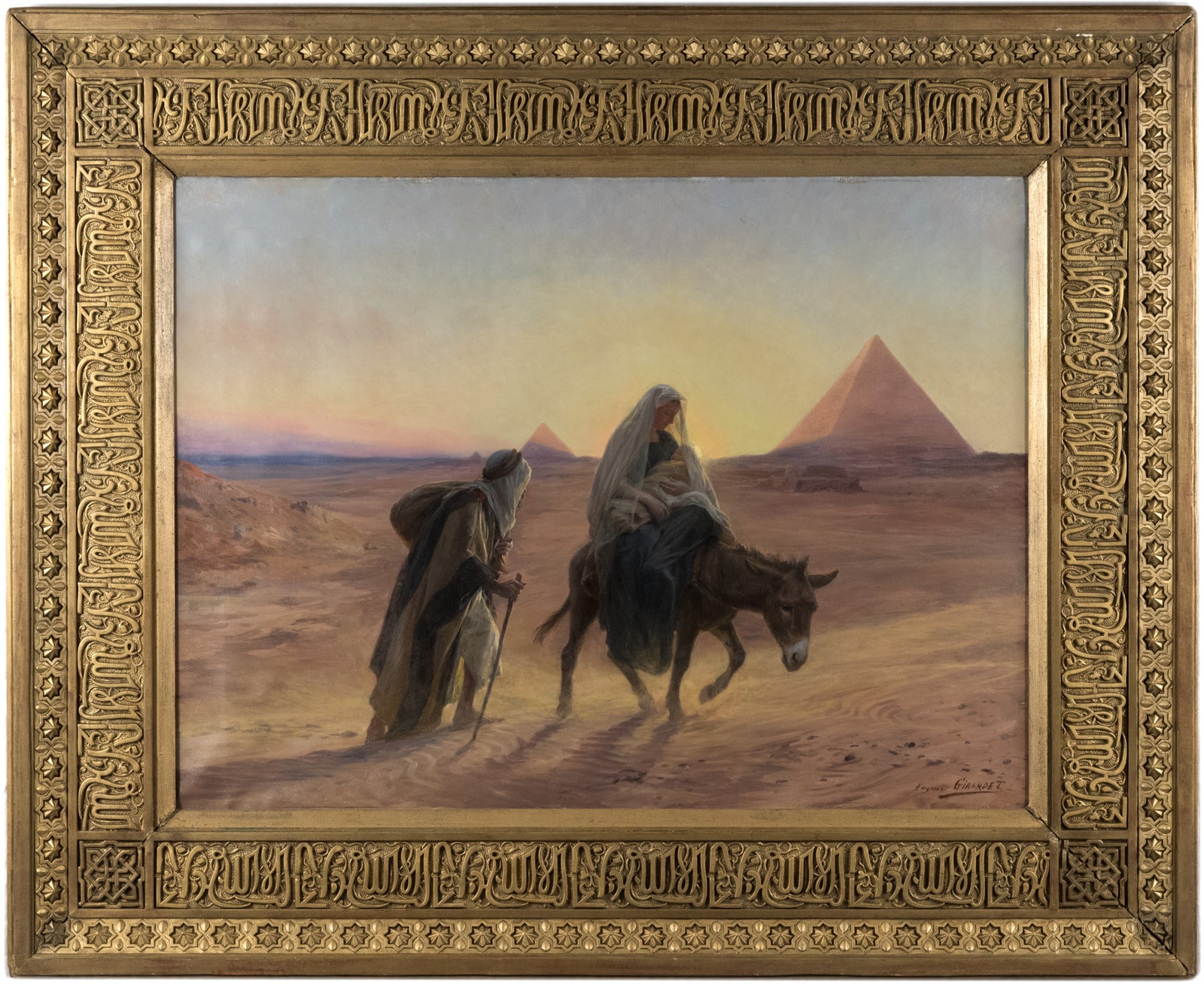La fuite en Égypte by Eugène Girardet

ABOUT THE PAINTING
And when they were departed, behold, the angel of the Lord appeareth to Joseph in a dream, saying, Arise, and take the young child and his mother, and flee into Egypt, and be thou there until I bring thee word: for Herod will seek the young child to destroy him.
When he arose, he took the young child and his mother by night, and departed into Egypt:
-Matthew 2:13,14
The subject of the Holy Family’s flight into Egypt has been depicted by nearly all of the great Old Masters, including Raphael, Albrecht Dürer, Rubens, and Rembrandt. This is despite none of these artists having visited the Middle East. Eugène Girardet painted this work after and 1890s trip to Egypt in the 1890s. Having seen the pyramids himself, he places Joseph, Mary, and the Christ child riding on a donkey in the deserts of Giza.
The artist draws a direct comparison between the pyramids, built as monuments to the sun-worshipping Pharaohs and the Christ child. As the sun rises in the East, it passes behind the Infant’s head, creating a halo and illuminating the pyramids. Girardet seems to indicate that the Christ Child’s influence eclipsed the wealth and power of the Pharaohs.
REFUGEES
At this moment, when world experiences the greatest refugee crisis in history, the story of the Holy Family takes on an increased significance.
Joseph was warned to take his family to Egypt just as Herod the Great, who sent his soldier to massacre the Innocent children of Bethlehem — a despicable and misguided precautionary effort to retain his rule. The Holy Family fled at a moment’s notice, at night. Girardet captures the difficulty of the journey. The family carries little but the clothes they wear. They push against the dusty wind in a dessert barren as far as the eye can see.
According to most scholars, the Holy Family spent between two and eight years in Egypt. This means that the adult Christ would have been old enough to remember living in a foreign land, far away from relatives and without a home. This brings greater significance to Christ’s later response to a disciple looking to join his mission:
And Jesus saith unto him, The foxes have holes, and the birds of the air have nests; but the Son of man hath not where to lay his head.
-Matthew 8:20
ABOUT THE ARTIST
Eugène Alexis Girardet was born to Swiss parents in Paris. For generations, the Girardets had been prominent printers. His father was a successful engraver and lithographer, who made his living copying the works of more well-known artists for the masses. When Eugène was accepted to the prestigious École des Beaux-Arts de Paris, he joined the first ranks of French artists. There Girardet became the protege of Jean-Léon Gèrôme (French, DATES), among the most influential artists of the nineteenth century.
In 1877, Girardet was one of the founders of the Société des Peintres Orientalistes Français (Society of French Orientalist Painters), reflecting a greater European interest in exploring and learning about the Middle East. He travelled to Tunisia, Algeria, Egypt and Palestine, capturing native people and customs, much like a visual anthropologist. And, his works were put on display at the Paris and Orientalist Salons for French audiences, for whom they were as much about art as about exploration
In 1897, the year that Girardet was working on his painting, Gèrôme was working on his own version of the work, a sculpture focusing exclulsively on Mary and Christ.

Jean Léon Gérôme (French, 1824-1904) La Fuit en Egypte (Flight into Egypt) 78 by 63 cm. (1897) Bronze patinated with polychrome. Purchased by Anthony’s Fine Art in London. Now in the BYU Museum of Art Collection.
It is likely that Girardet saw his mentor’s version and let it influence his own. But, where Gèrôme depicts a calm scene, Girardet captures the travail in the midst of history and beauty.
THE FRAME
The frame is original to the work and was chosen by Eugéne Girardet. The decorative script running along its border is an elaborate reproduction of the first portion of the Islamic creed, the shahada, which states “There is no God but God alone.” (It also translates as “God is victorious.”)

Frame from Girardet’s Flight into Egypt, above. And script from the entrance to Alhambra Palace, Córdoba.
From the earliest time, the script appears on Islamic structure, including the Dome of the Rock in Jerusalem. This particular version looks very similar to an inscription on Spain’s Alhambra Palace in Córdoba. Similar motifs and excepts from the shahada can be found on architectural works all around the world at the end of the nineteenth century, including the LDS Temple in Manti, Utah, which included such designs on the hardware of its interior doors.

Manti Temple Door Knob with Arabic script designed by John Patrick Reed, c. 1880.




